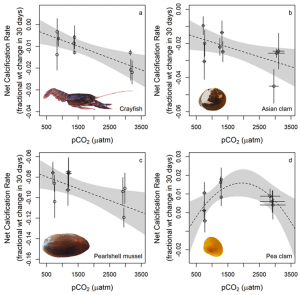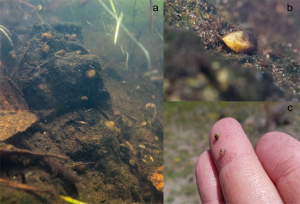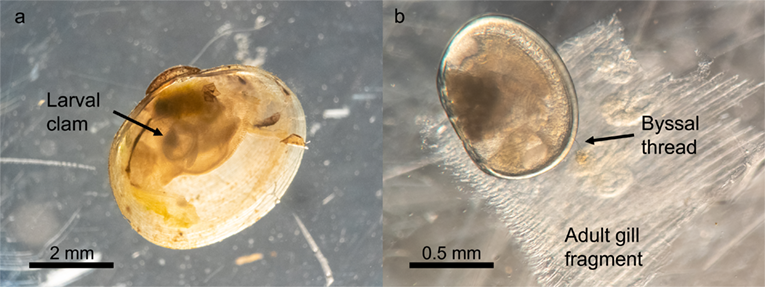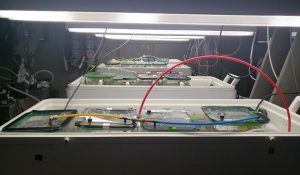 The San Juan Archipelago is blessed with diverse marine and terrestrial habitats and organisms, but most of the research conducted at the Friday Harbor Labs focuses on the wet and salty side. Aaron Ninokawa’s essay below shows that some research questions translate almost seamlessly between the ocean and freshwater, and in fact certain hypotheses that can be tested on freshwater organisms will help inform what is happening in marine habitats. I am thrilled that Aaron has brought his expertise to FHL and he has done tremendous work upgrading our ocean acidification lab – and am impressed at his patience handling and working with very tiny clams!
The San Juan Archipelago is blessed with diverse marine and terrestrial habitats and organisms, but most of the research conducted at the Friday Harbor Labs focuses on the wet and salty side. Aaron Ninokawa’s essay below shows that some research questions translate almost seamlessly between the ocean and freshwater, and in fact certain hypotheses that can be tested on freshwater organisms will help inform what is happening in marine habitats. I am thrilled that Aaron has brought his expertise to FHL and he has done tremendous work upgrading our ocean acidification lab – and am impressed at his patience handling and working with very tiny clams!Gaining a “fresh” perspective on ocean acidification
by Aaron Ninokawa
Climate change resulting from increased emissions of carbon dioxide is a major issue facing global communities. One aspect of climate change that is particularly concerning is ocean acidification. This occurs when that extra carbon dioxide enters the ocean to form carbonic acid, which makes the seawater more acidic (causing a reduction in pH). Organisms that form shells, like mussels and oysters, are especially impacted by this process as they have a harder time growing and producing high-quality shells in an acidified ocean. Extensive research in marine systems has revealed that responses of species to acidification can differ depending on a wide range of factors like the organism’s life stage, type of shell material, exposure history, etc.

However, there are also numerous shell-forming species that live in freshwater environments like lakes and rivers. While decades of acid rain research have revealed that freshwater species are negatively impacted by acidification in general, acid rain alters water chemistry in a different way and the magnitude tends to be greater than carbon dioxide-induced acidification. Other studies have experimentally acidified freshwater with very high concentrations of carbon dioxide in “bubble walls” to prevent the migration of invasive species (e.g. zebra mussels and fish), but these changes are much more extreme than what’s expected with human carbon dioxide emissions alone. Understanding how freshwater species will respond to more moderate acidification resulting from global climate change will help us to not only predict how freshwater communities will fare in the future but may also help us learn more about their marine analogues.
Last year, I spent the spring and summer at the UC Davis Tahoe Environmental Research Center conducting an experiment with Dr. Justin Ries from Northeastern University. Our goal was to determine whether freshwater acidification associated with climate change is a problem for four shell-forming species, three bivalves and a crayfish. Three of the four species we tested grew slower when faced with freshwater acidification (Figure 1). The fourth, the pea clam, performed better with moderate acidification but lost that advantage in the most acidified treatments. These results suggest that we need to be concerned about carbon dioxide induced acidification in addition to all the other impacts humans have on freshwater ecosystems.

Funded by a postdoctoral fellowship from the National Science Foundation, I arrived at FHL last year shortly after completing this experiment. Much of my prior work was done at another west coast marine lab, the Bodega Marine Lab, where I studied how marine organisms are affected by the chemical alterations associated with ocean acidification. I also have worked on quantifying their ability to actively change the water chemistry surrounding them through biological processes like photosynthesis and respiration. I have been combining these themes to understand how species interactions might alter the outcomes of ocean acidification for marine mussels. But as I settled into the UW Labs and began exploring all the nature that San Juan Island has to offer, I was ecstatic to find that the freshwater lakes and ponds here are filled with a diverse assemblage of freshwater clams.
Broadly, these are commonly called fingernail or pea clams due to their small size (Figure 2). While I have seen a few individuals of one species that reaches just over 2 cm, most of the species on the island are closer to 5 mm (~1/4 inch) as adults. But despite their diminutive size, they actually brood their young! These clams are raised within the adult shell (Figure 3) until they are ready to crawl away as juveniles (~0.5-1 mm). The young are held within specialized sacs attached to the adult’s gills and they will even use byssal threads (similar to the ones holding marine mussel beds together!) to remain there until their organs are fully developed. As a result, it is possible to open up a single clam and find up to 40 tiny clams, though around 4-8 seems more common here. Naturally, except for occasional dispersal by birds or insects, it is hard to imagine these clams traveling far during their lifetime. Therefore, they have this incredible ability to aestivate (similar to hibernation) where they can dramatically shut down their metabolism so that they can survive stressors like extreme cold or drying up – which is useful if they cannot migrate to a better habitat.

As I continue my research at FHL, I am excited to keep exploring the freshwater environments of the island. Are the clams here as tolerant to mild acidification as the Lake Tahoe clams? If so, at what threshold would we expect their numbers to dwindle? These clams are an important food source for fish and can help clarify water by their filter-feeding activities, so gaining a better understanding of how climate change impacts their growth and survival will help us understand how to best protect them and the ecosystem services they provide.

It just so happens that I am in the perfect place to explore the CO2 sensitivity of these clams. I first heard about FHL’s Ocean Acidification Environmental Laboratory (OAEL) as an undergraduate student at Cal State Fullerton and have followed the work produced by scientists here ever since. From increased CO2 to increased temperature, the OAEL has been at the forefront of investigating the ecological consequences of climate change on marine ecosystems since its inception in 2011 by Dr. Emily Carrington’s research group. Now that I am here, I am honored to have the opportunity to expand on the OAEL’s legacy. Over the past year, I have been working to facilitate its usage by others and we have been restoring many of its former experimental and analytical capabilities (Figure 4). It is great to see this wonderful facility now back to running constantly at full capacity! As I continue to conduct experiments testing the effects of species interactions in shaping responses to ocean acidification, I am excited to further utilize the OAEL in support of gaining a better understanding of how climate change can also impact freshwater ecosystems.
